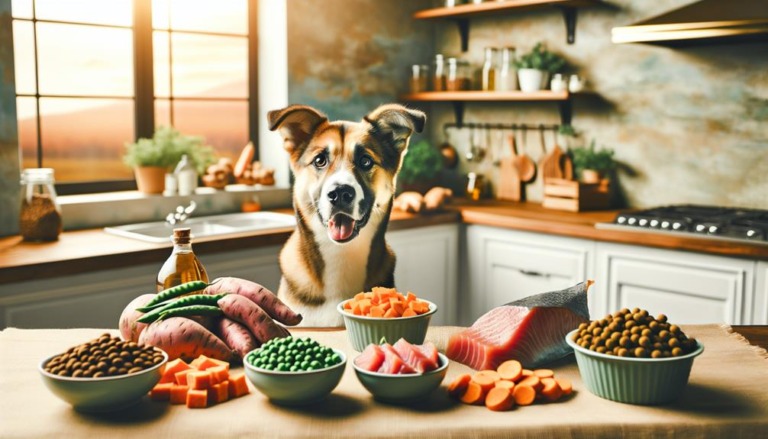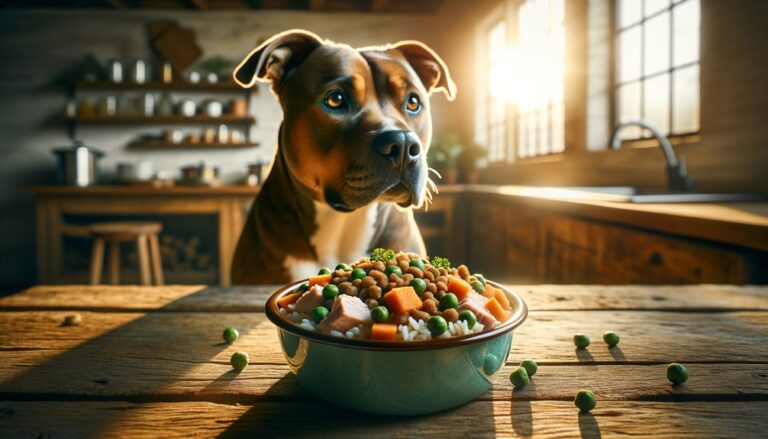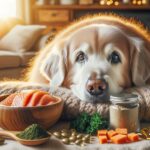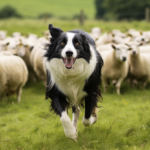The Best Fluffy Pancakes recipe you will fall in love with. Full of tips and tricks to help you make the best pancakes.
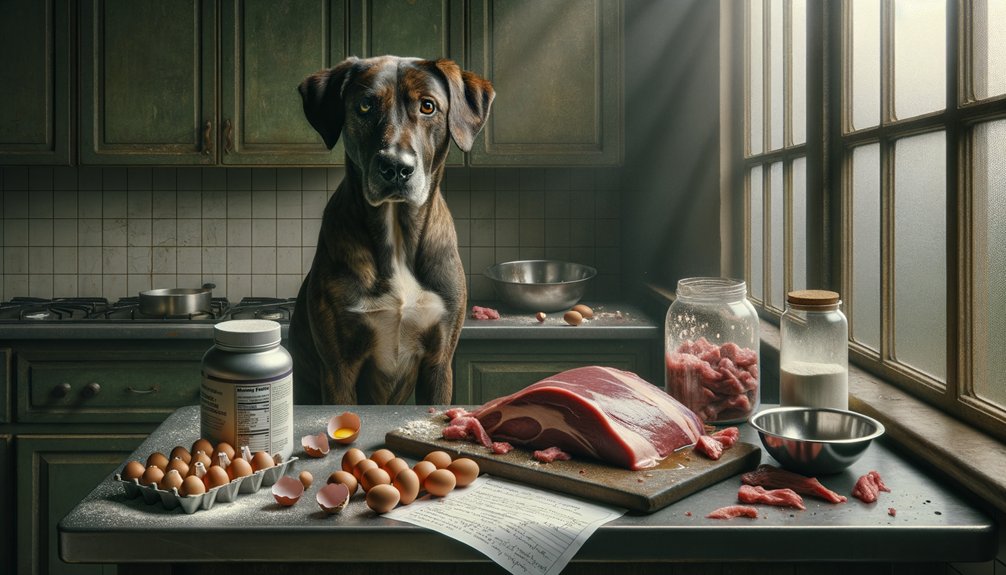
Not all homemade or raw dog diets are safe—serious bacterial, parasitic, and nutritional risks could affect pets and families, so read on to learn why. If you’re feeding or considering raw or homemade meals, you need to know they carry measurable risks: bacterial pathogens (Salmonella, Campylobacter, Listeria, E. coli), parasites, nutrient imbalances, and bone‑related injuries that can harm both pets and household members. These dangers are heightened for children, pregnant people, and immunocompromised individuals, and they often require veterinary assessment and validated recipes to mitigate—so there’s more to consider.
Key Takeaways on Raw and Homemade Pet Diets
- Raw feeding, BARF diets, and homemade dog food are becoming increasingly popular among pet owners searching for a natural feeding approach. However, research from the U.S. Food and Drug Administration (FDA) and the American Veterinary Medical Association (AVMA) highlights that these diets can expose pets and families to harmful bacteria such as Salmonella, Campylobacter, Listeria, and E. coli, which are strongly linked to foodborne illness in pets and humans. Queries like “is raw dog food safe for puppies?” or “raw feeding risks for cats” often point to these concerns.
- An imbalanced calcium-to-phosphorus ratio (Ca:P balance) or missing micronutrients in DIY diets can cause growth plate problems, metabolic bone disease, and chronic organ stress. According to the World Small Animal Veterinary Association (WSAVA), following pet nutrition safety guidelines and consulting a BARF feeding guide is essential to avoid homemade dog food nutrition mistakes.
- Bones—whether raw or cooked— may appear natural, but they frequently lead to dental fractures, oral injuries, intestinal blockages, or gastrointestinal perforations, making them a high-risk feeding choice. Veterinary case reports confirm these as common emergencies in clinics.
- Parasites such as Toxoplasma, Trichinella, Giardia, and Taenia, along with hidden toxins or contaminants, create zoonotic diseases and long-term health risks for both pets and households. The Centers for Disease Control and Prevention (CDC) warns that raw dog food safety depends heavily on strict hygiene and parasite control.
- Cross-contamination and poor food handling practices increase infection risks at home, especially for children, pregnant women, seniors, and immunocompromised individuals. Practicing safe handling of raw pet food—separating raw meat from other foods, disinfecting surfaces, and washing hands—is strongly recommended
- Despite the risks, many owners choose raw or homemade diets because they value ingredient transparency, perceived health benefits, and improved palatability. With veterinary nutrition advice or guidance from a pet nutrition specialist, it is possible to design a balanced diet for dogs and cats that supports long-term health while minimizing risks.
Microbial Contamination and Zoonotic Risks
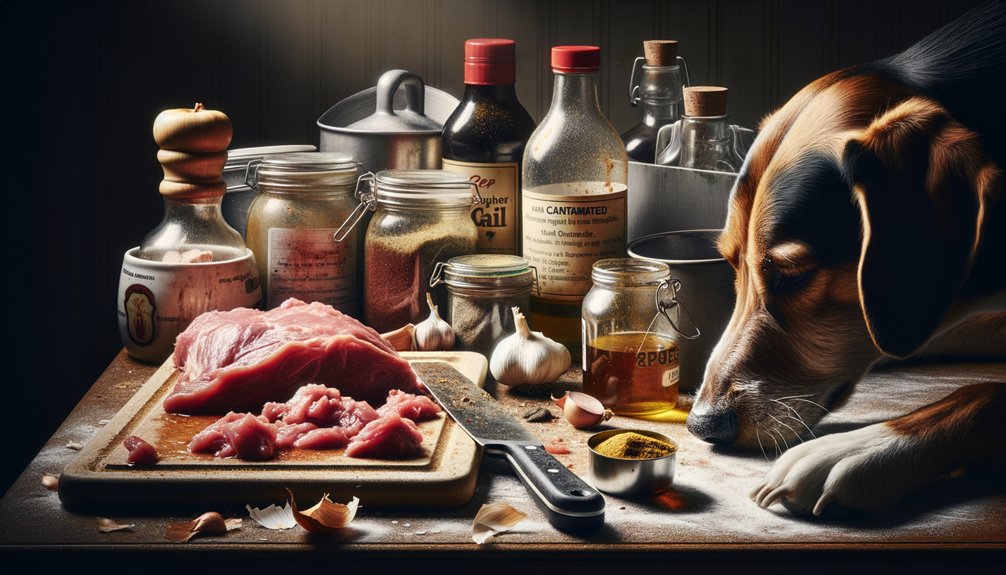
How can raw or home-prepared dog diets put you and your pet at risk? You’ll encounter measurable microbial contamination in raw meats—Salmonella, Campylobacter, Listeria and pathogenic E. coli have been repeatedly isolated from commercial and kitchen-prepared raw diets.
Raw or home-prepared dog diets often carry Salmonella, Campylobacter, Listeria and pathogenic E. coli — risking pets and people.
These organisms can colonize your dog transiently or persistently, shedding in feces and contaminating household surfaces. That creates clear zoonotic risks to people, especially children, pregnant women, older adults and immunocompromised household members.
You should assume routine handling without strict hygiene increases transmission probability; studies show inadequate handwashing and cross-contamination of utensils raise infection rates.
Clinical guidance recommends against feeding raw diets when vulnerable humans are present and advises validated pathogen-control steps if owners persist: separate prep areas, dedicated utensils, immediate refrigeration, and rigorous hand hygiene.
You’ll reduce but not eliminate risk; clinicians weigh household composition and owner capacity for consistent infection-control before endorsing such feeding practices.
Nutritional Deficiencies and Imbalances
When you prepare or select a home or raw diet, you risk creating a calcium-to-phosphorus imbalance that can impair bone development and metabolic function.
You may also omit or under-supply essential fat-soluble and water-soluble vitamins (A, D, E, B-complex) with measurable clinical consequences.
Routine nutrient analysis and veterinary oversight are required to identify and correct these deficits.
Calcium-To-Phosphorus Imbalance
An improper calcium-to-phosphorus (Ca:P) ratio in home-prepared or raw diets can cause serious skeletal and metabolic problems in dogs. You’ll see calcium imbalance or phosphorus imbalance manifest as growth plate abnormalities, osteopenia, fractures, or secondary hyperparathyroidism when ratios deviate from the recommended 1:1 to 2:1 range. Clinical data show immature dogs are especially vulnerable; adults may develop chronic bone and renal sequelae. You should measure and balance dietary sources—bone meal, muscle meat, organs, and supplements—rather than guessing. Work with a veterinary nutritionist to calculate an evidence-based formulation and confirm adequacy via periodic biochemical and radiographic monitoring. As a caregiver within a community of informed owners, you’ll reduce risk validated recipes and professional oversight.
Missing Essential Vitamins
Imbalances in minerals like calcium and phosphorus often appear alongside other nutrient gaps in homemade or raw diets, and vitamins are commonly overlooked contributors to morbidity. You may think whole foods cover every need, but evidence shows missing vitamins (A, D, E, B-complex, K) and inadequate essential minerals exacerbate clinical problems. Deficiencies cause specific syndromes: vitamin D insufficiency worsens osteomalacia and growth delay; vitamin A deficits impair vision and epithelial health; B-vitamin shortages produce neurologic and hematologic signs. You should screen diets quantitatively or use veterinary-formulated supplements to prevent these predictable failures. Work with clinicians to assess serum markers, clinical status, and adjust formulations. That collaborative approach keeps your dog healthy while honoring your desire to feed intentionally.
Bone-Related Hazards and Dental Damage
How often do owners realize that feeding whole bones can cause both mechanical and gastrointestinal injury? You should know that bone hazards include fractured teeth, oral lacerations, esophageal obstruction, gastric perforation, and intestinal impaction. Clinical studies and case series document dental damage from hard bones—fractured cusps, root exposure, and tooth loss—often requiring extraction or endodontic therapy. You might expect chewing to provide natural tooth wear, but improper tooth wear from inappropriate bone types or size mismatches accelerates abnormal attrition and leads to occlusal trauma. When you recommend or choose bones, weigh risk factors: bone density, shape, size relative to jaw, and the animal’s chewing strength and behavior. Monitor for hypersalivation, oral bleeding, pain, changes in eating, or vomiting—signs that need prompt veterinary assessment. In shared-care communities, acknowledge diverse experiences but prioritize evidence-based guidance: avoid whole weight-bearing and cooked bones, supervise chewing, and select veterinary-approved dental aids to reduce bone-related hazards.
Foodborne Parasites and Protozoa
What parasites and protozoa can you expect from raw or home-prepared diets? You’ll encounter foodborne parasites such as Toxoplasma gondii, Trichinella spp., and tapeworms (e.g., Dipylidium, Taenia) plus protozoa like Giardia and Cryptosporidium.
These agents survive in raw meat, offal, and fecally contaminated ingredients and can infect dogs and people as zoonoses. Clinical evidence shows variable incubation, from days (Giardia) to weeks (Toxoplasma), and signs range from asymptomatic carriage to diarrhea, weight loss, or systemic illness in immunocompromised hosts.
You should recognize that routine veterinary screening and targeted diagnostics (fecal flotation, antigen testing, PCR) detect many infections; treatment requires antiparasitic or antiprotozoal drugs tailored to the organism. Preventive strategies include sourcing inspected meats, freezing protocols that reduce some parasites, and veterinary guidance. You’ll belong to a cautious community when you prioritize validated testing and consult clinicians to minimize foodborne parasite and protozoa risks and associated zoonoses.
Cross-Contamination in the Home Kitchen
Beyond the direct infection risks from contaminated ingredients, handling raw or home-prepared diets creates a high potential for cross-contamination in the kitchen that can spread bacteria, parasites, and their eggs or cysts to surfaces, utensils, people, and other foods. You’ll transfer pathogens when raw juices contact countertops, cutting boards, or refrigerator shelves, and those agents can persist if not removed with validated cleaning. Clinical studies show common organisms (Salmonella, Campylobacter, Listeria) survive on fomites and resist simple rinsing. You should implement strict kitchen hygiene: designate separate equipment for pet food, use hot detergent followed gloves or wash hands for at least 20 seconds after contact with raw diets and avoid touching your face or other foods. Adopt routine cleaning logs and communicate shared expectations with household members so everyone feels included and accountable. These measures reduce cross contamination and protect both human and animal household members.
Improper Handling and Storage Practices
Why do improper handling and storage practices matter for raw and home-prepared dog diets? You increase risk when you don’t follow consistent protocols: leaving raw protein at room temperature, using inadequate refrigeration, or failing to separate batches all promote microbial contamination. Evidence shows bacterial loads rise rapidly in the temperature danger zone, and lapses in handling increase pathogen survival and proliferation.
You should adopt precise, reproducible steps: chill ingredients promptly, maintain refrigerators at ≤4°C (≤40°F), freeze long-term portions, and use sealed, labeled containers to prevent cross-contact. Clean and sanitize utensils and surfaces between use, and discard items beyond recommended storage durations. Monitor fridge temperature with a probe and document deviations.
Hidden Additives, Toxins, and Allergen Issues
How can hidden additives, toxins, and allergens undermine the safety and nutritional adequacy of raw and home‑prepared dog diets?
You may unknowingly introduce hidden additives—preservatives, flavor enhancers, or supplements—when using commercial components or human foods, altering nutrient balance and masking spoilage.
Environmental toxins (heavy metals, mycotoxins, pesticide residues) can concentrate in certain meats and organs, exposing your dog to cumulative harm.
Allergen issues are common: novel proteins or cross‑contaminated ingredients can trigger dermatologic or gastrointestinal disease, and you might miss subtle chronic reactions without systematic monitoring.
These factors interact with bacterial contamination risks, increasing clinical complexity and complicating diagnosis.
Combined with bacterial contamination, hidden toxins and allergens multiply clinical complexity and make diagnosis far more challenging.
You should apply evidence‑based screening: choose tested sources, limit high‑risk tissues, rotate proteins cautiously, and document reactions.
Collaborate with peers and clinicians who prioritize shared learning to detect patterns.
Doing so reduces unpredictable exposures, supports targeted investigation when problems arise, and helps maintain a safer, more inclusive approach to feeding choices.
Lack of Veterinary Oversight and Formulation Errors
When you prepare home or raw diets without veterinary guidance, you increase the risk of nutritional imbalances that can cause growth, immune, and metabolic problems. You may omit critical supplements (like calcium, taurine, or vitamin D) or miscalculate amounts, leading to deficiency or toxicity. You’ll also be prone to improper portion calculations that result in underfeeding or chronic overnutrition with attendant clinical consequences.
Nutritional Imbalances Risk
Could insufficient expertise put your dog at risk? You may mean well, but without veterinary guidance you can create persistent nutritional imbalances. Errors in calcium balance and protein adequacy are common and clinically significant, affecting bone growth, renal function, and muscle maintenance. You want your dog to thrive; team-based care prevents harm.
- Inaccurate calcium-to-phosphorus ratios impair skeletal development and can cause metabolic bone disease.
- Over- or underestimating protein needs leads to sarcopenia or renal stress, depending on life stage and comorbidity.
- Fat-soluble vitamin excess or deficiency disrupts homeostasis and organ function.
- Micronutrient interactions alter absorption and clinical outcomes.
- Lack of periodic assessment misses progressive imbalances.
Stay connected with your veterinary community to ensure safe, evidence-based nutrition.
Missing Critical Supplements
Why would skipping supplements matter? You risk clear clinical deficits when missing supplements because diet formulation without veterinary oversight often omits essential vitamins and minerals. You need evidence-based guidance to prevent long-term, sometimes irreversible, outcomes. Consult a veterinary nutritionist; don’t rely on internet recipes.
| Emotional cue | Clinical consequence | Call to action |
|---|---|---|
| Worry for pet’s future | Bone deformities, anemia | Seek expert review |
| Desire to belong | Social support for safe feeding | Join vet-guided groups |
| Responsibility | Biochemical deficiencies | Use tested formulations |
You belong to a community that prioritizes health. Use validated diet formulation protocols and professional oversight to avoid avoidable harm from missing supplements.
Dog Nutrition Guide 2025
Hidden Danger in Your Dog’s Bowl
Feeding your dog a homemade diet or raw diet may seem healthy, but portion accuracy is the factor that decides whether your dog stays fit or becomes overweight.
- Over 60% of U.S. dogs are overweight or obese.
- A 10% daily calorie error can lead to visible weight gain in just three months.
Without veterinary guidance, owners risk nutrient imbalances, obesity, and long-term health problems.
5 Portioning Mistakes That Shock Owners
- Energy density confusion → Lean turkey ~1,200 kcal/kg vs fatty lamb >2,500 kcal/kg.
- Moisture blind spots → Raw chicken breast ~73% water vs kibble ~10%.
- Absorption gaps → Calcium: bone meal ~60% vs eggshell powder ~95%.
- Measuring cups instead of scales → A cup of raw beef can vary by 40 g (~80 kcal).
- No reassessment → Needs change after neutering, aging, or lifestyle shifts.
Tip: Cups measure volume, not weight. A digital kitchen scale is the only way to ensure accuracy.
Rules & Hacks Every Owner Needs – Plus a Labrador Case
- Weigh every meal with a digital kitchen scale (accuracy ±1 g).
- Account for moisture content (raw vs cooked).
- Reassess monthly — if weight shifts >5%, update portions.
- Follow AAFCO, WSAVA, AAHA nutrition standards.
- Adjust meals based on Body Condition Score (BCS).
- Schedule vet check‑ups every 6–12 months.
- Use professional recipes, not generic calculators.
Case Study
- A 20‑kg neutered Labrador requires ~1,000 kcal/day.
- Owner eyeballs 1.5 cups raw beef → ~1,250 kcal/day.
- Surplus: +250 kcal/day → +2.5 kg in 3 months → overweight. With a digital scale, this risk disappears.
5 Tips That Transform Dog Feeding
- Track calories like expenses → consistency prevents hidden surpluses.
- Create a feeding log → record portions, weight changes, and activity levels.
- Limit treats → keep them under 10% of daily calories.
- Rotate protein sources → balance nutrients and avoid monotony.
- Consult your vet before diet changes → every dog has unique needs.
From Scraps to Precision Feeding
Dog feeding has evolved dramatically — from survival scraps to modern science.
- Ancient Rome: Varro recommended meat & barley bread.
- Middle Ages: Hunting dogs ate buttered eggs & goat’s milk.
- 19th century: Spratt’s Dog Cakes → first commercial dog food.
- 20th century: Kibble convenience.
- 21st century: Raw & homemade diets surged → portioning mistakes became the new risk.
Now, the future of dog nutrition is about precision and personalization:
- Digital scales & nutrition calculators are becoming standard.
- Veterinary oversight adapts diets to age, lifestyle, and health.
- Evidence-based standards replace guesswork, making homemade and raw diets safer than ever.
Dog nutrition is no longer just feeding — it’s a dynamic, adaptive plan that ensures long-term health, weight management, and vitality.
Raw Pet Diets: Safety, Nutrition, Health Risks, Sustainability, and Legal Considerations for Pet Owners
Can Raw Diets Increase Antibiotic-Resistant Bacteria Exposure in Households?
Yes — feeding pets a raw diet can increase the risk of antibiotic-resistant bacteria, foodborne pathogens, and microbial contamination entering your home. Handling raw meat may spread harmful organisms such as Salmonella, Listeria, or E. coli, some of which are resistant to common antibiotics. This creates potential for cross-contamination, household exposure, and even zoonotic diseases (infections transmitted from animals to humans). To reduce risk, follow strict hygiene protocols: wash hands, disinfect surfaces, use separate food preparation tools, and store food safely. Consulting a veterinarian or pet nutritionist ensures safer feeding practices and protects both pet health and family wellbeing.
How Do Raw Diets Affect Shelf Life and Food Waste Management?
Raw pet food has a shorter shelf life than processed kibble or canned diets, leading to faster spoilage, nutrient degradation, and higher food waste. Maintaining a cold-chain system (consistent refrigeration or freezing) is critical to preserve freshness, nutritional value, and food safety. Clear expiration labeling, batch tracking, and improved storage infrastructure help reduce waste. From a sustainability perspective, raw diets raise concerns about carbon footprint, energy consumption, resource efficiency, and environmental impact. Ongoing research funding, public health guidance, and sustainable feeding practices are needed to balance pet wellness, eco-friendly nutrition, and responsible waste management.
Do Raw Diets Influence Canine Gut Microbiome Diversity Long-Term?
Yes — raw diets can alter the gut microbiome of dogs, but results vary. Some studies show short-term microbial shifts, including increases in beneficial bacteria, digestive enzyme activity, and intestinal flora diversity, while long-term outcomes remain inconsistent. Potential effects include digestive health improvements, immune system support, and nutrient absorption changes. To evaluate these outcomes, experts recommend clinical monitoring, dietary stabilization, and more longitudinal studies. Incorporating probiotics, prebiotics, and focusing on microbiota balance can guide evidence-based feeding strategies that promote long-term canine digestive health.
Can Neighborhood Wildlife Be Attracted
Yes — raw food odors can attract wildlife, pests, and scavengers such as raccoons, rodents, stray cats, foxes, or even insects. This increases risks of property damage, disease transmission, urban pest infestations, and biohazard exposure. To minimize attraction, store food in airtight containers, keep it refrigerated or frozen, and clean preparation areas promptly. Effective odor control, sanitation practices, and waste disposal not only prevent unwanted visitors but also protect pets from secondary infections and reduce public health risks.
Are There Legal or Insurance Implications of Feeding Raw Diets to Pets?
Yes — there may be legal liabilities, insurance exclusions, and compliance issues linked to raw feeding. If a raw diet causes illness, contamination, or injury to others, pet owners could face lawsuits, liability claims, or policy disputes. Some homeowner or pet insurance policies exclude coverage for nonstandard feeding practices. To safeguard yourself, review your insurance policy, keep veterinary documentation, and follow professional feeding guidelines. This ensures compliance with animal welfare standards, reduces the risk of legal disputes, and protects both your household and your pet’s wellbeing.
“The Hidden Truth About Raw Dog Food”
Feeding dogs with raw or homemade diets may sound wholesome and natural, but the reality is far riskier than most pet owners realize. Without professional guidance, these approaches can compromise dog nutrition safety and expose both pets and families to serious health threats.
The Risks You Can’t Ignore
- Bacterial infections such as Salmonella and E. coli that endanger pets and humans alike.
- Parasites and pathogens from poorly sourced or contaminated ingredients.
- Nutritional deficiencies caused
- Physical injuries from unsafe or improperly prepared foods.
Common Questions from Pet Owners
- “Is raw dog food really safe?” → It may look natural, but raw feeding often carries hidden raw feeding risks.
- “What are the dangers of homemade diets?” → Improvised meals lack balance, undermining a balanced canine diet and leading to long‑term health issues.
- “How can I make a homemade diet safe?” → and consulting a board‑certified veterinary nutritionist.
Why It Matters for Families
Your dog’s diet is not just about pet wellness—it directly impacts household health. A carefully designed, science‑driven nutrition plan:
- Protects against zoonotic diseases.
- Promotes longevity and vitality in pets.
- Creates a safer, healthier environment for the entire family.
Conclusion
Choosing expert‑guided, balanced nutrition over risky improvisation transforms raw feeding from a gamble into a proactive commitment to pet wellness, safety, and quality of life. dog nutrition safety and embracing a balanced canine diet, you protect not only your dog’s future but also the well‑being of your family.



